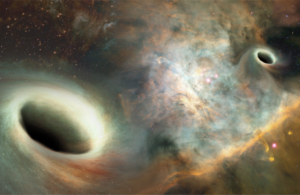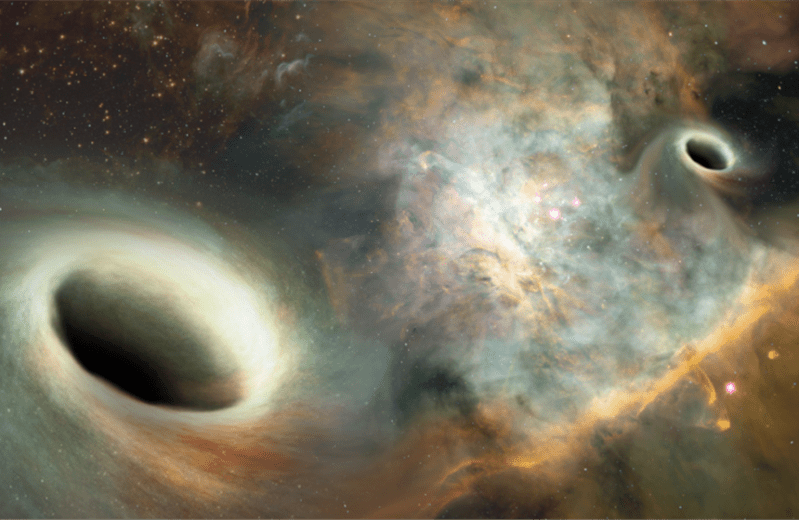
A recent groundbreaking discovery by researchers including Stanford physics professor Roger W. Romani confirms the existence of supermassive black holes orbiting each other in a galaxy 750 million light years away from Earth.
The radio galaxy 0402+379 is believed to host a supermassive black hole binary. According to a study published in The Astrophysical Journal, the compact supermassive black hole binary system was originally discovered in 2006, which confirmed the existence of two major black holes, but the nuclei appeared to be stationary.
“This is an example of the closest black holes ever found, but they will not merge,” said Romani, co-author of the paper. “In most cases, when this process occurs, the two galaxies come together, and the central black holes get close enough for the gravitational energies to take over and combine them in a reasonably short time, eliciting a burst of gravitational radiation, very much like the ones seen in LIGO project.” The LIGO project discovered stellar mass black holes (which are 30 times the mass of our own sun), but these newly discovered objects are billions of times the mass of the sun, so the total energy release will be billions of times larger.
“For a long time, we’ve been looking into space to try and find a pair of these supermassive black holes orbiting as a result of two galaxies merging,” said Greg Taylor, professor of Physics & Astronomy at UNM, explained in a UNM news release. “Even though we’ve theorized that this should be happening, nobody had ever seen it until now.”
Interestingly enough, if these two black holes had been closer or if there were another source of friction to bring them together, they would merge in a burst of gravitational energy. Romani speculates that there must be an extra source of friction in other galaxies for black holes to eventually merge. These supermassive black holes won’t merge if only gravity acts.
“In this case, we see them as separate,” Romani said. “In fact, we have some evidence that they’ve been separated for quite a long time, several billion years, which implies to us whatever source of friction that usually brings them together did not operate in this case.”
“Quite uniquely, after looking at thousands of galaxy, we see these two black holes as two at such a close separation.”
Mergers seem to be a crucial phase of a blackhole’s lifetime, but this system is unique because it is an exception to that rule. However, it seems like they’re not merging.
“I would argue, if we can understand why these guys fail, it makes it more likely that we’ll figure out why all the other ones (which we don’t see because they’ve already merged), why they merged,” Romani said.
Just before merging, the orbital periods of a black holes of this mass would be on the scale of years. The black holes are still light years apart and the orbital periods are tens of thousands of years, but if an extra source of friction seems to bring them in, the periods would begin to get consistently shorter. The most interesting thing about these black holes is that they will not merge into an explosion of gravitational radiation; they are still separate. Romani speculates that like most, these black holes want to merge. However, most likely either the holes are too heavy or the gas that provides the friction has been exhausted in the center, so they will not combine in the timespan of our universe.
“In this case, we’re very limited by the fact that the orbital period is almost certainly, many tens of thousands of years, and only a small fraction of a full orbit has been completed.” Romani said. “ To use the orbit to analyze the objects, we could just put 5-10 years measuring this, we have to measure their Doppler shifts (in or out of the sky) of the sources to use the black hole’s orbits to our full potential.”
Romani strongly believes that most systems happen relatively quickly on a human timescale. He explains that when one looks at the sky, they make a snapshot of what’s going on.
When you take a snapshot, most things are in the long-lived phases of their existence. In the case of these black hole binaries, it seems that the period of when the two galaxies get together and either merge or get thrown apart, seems to be shorter,” Romani said. “Catching something in the act is fairly difficult due to the friction that brings them closer together. When we survey the sky, very few will be in that state. This one example is special, because we theorize that the normal process that brings them together, didn’t work.”
Similarly, Romani believes that 4 to 5 billion years in the future, the Andromeda galaxy’s black hole and our Milky Way’s will get closer together (with the extra source of friction, that is not yet fully understood by scientists) until gravity takes over and combines them together. Romani theorizes that black holes interact with each other’s orbits quite often, several times in the history of each galaxy. He suggests that this new discovery is particularly unique because they won’t seem to merge (unless acted on by another powerful source of friction, other than gravity) because they are too far apart.
Romani states that the researchers used the VLBA (Very Long Baseline Array, a system made up of 10 radio telescopes across the U.S.). This has been developed and improved upon for over 30 years.
“The breakthrough here is not so much revolutionary, as evolutionary.” Romani said. This is a case where the techniques for measuring the positions of such sources have been slowly improving. This particular system is well designed to make the measurements as easy as they could be. “It’s not like we invented this magic new thing. We just kept working at it and kept improving the measurements.”
Contact Pratyusha Macherla at pmacherla09 ‘at’ gmail.com
